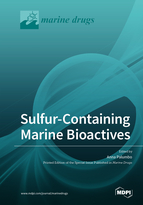Sulfur-Containing Marine Bioactives
A special issue of Marine Drugs (ISSN 1660-3397).
Deadline for manuscript submissions: closed (15 December 2020) | Viewed by 25301
Special Issue Editor
Interests: response of marine organisms to emerging contaminants; antioxidants; 5-thiohistidines; nitric oxide signalling; biotechnological potential of marine organisms
Special Issues, Collections and Topics in MDPI journals
Special Issue Information
Dear Colleagues,
Sulfur is an essential element for all living organisms, required by algae, plants, fungi, animals and humans for growth and development. It is present in a variety of biomolecules involved in many biological functions, including the maintenance of cell redox homeostasis, defense and detoxifying processes. The alteration of sulphur compound metabolism may lead to human diseases as well as to plant and animal pathologies.
The marine environment, which is characterized by a high biodiversity of species and a great chemical diversity, represents a great potential source of sulfur bioactive molecules. A broad range of biologically active sulfur compounds with unique structures and pharmacological properties have been reported to occur in marine organisms, from aminoacids to different sulphated derivatives. Great attention is also focused on sulfur metabolites in the marine microbial world in relation to the global sulfur cycle.
The aim of this Special Issue is to present the existing knowledge and recent studies on sulfur-containing marine compounds bioactive on different biological systems. Attention is also focused on the metabolites active at the ecological level.
I cordially invite researchers to contribute to this Special Issue by submitting original research articles and review papers.
Dr. Anna Palumbo
Guest Editor
Manuscript Submission Information
Manuscripts should be submitted online at www.mdpi.com by registering and logging in to this website. Once you are registered, click here to go to the submission form. Manuscripts can be submitted until the deadline. All submissions that pass pre-check are peer-reviewed. Accepted papers will be published continuously in the journal (as soon as accepted) and will be listed together on the special issue website. Research articles, review articles as well as short communications are invited. For planned papers, a title and short abstract (about 100 words) can be sent to the Editorial Office for announcement on this website.
Submitted manuscripts should not have been published previously, nor be under consideration for publication elsewhere (except conference proceedings papers). All manuscripts are thoroughly refereed through a single-blind peer-review process. A guide for authors and other relevant information for submission of manuscripts is available on the Instructions for Authors page. Marine Drugs is an international peer-reviewed open access monthly journal published by MDPI.
Please visit the Instructions for Authors page before submitting a manuscript. The Article Processing Charge (APC) for publication in this open access journal is 2900 CHF (Swiss Francs). Submitted papers should be well formatted and use good English. Authors may use MDPI's English editing service prior to publication or during author revisions.
Keywords
- Sulfur compounds
- Sulfur cycle
- Bioactive molecules
- Marine natural products
- Redox homeostasis
Related Special Issue
- Sulfur-Containing Marine Bioactives 2.0 in Marine Drugs (4 articles)







